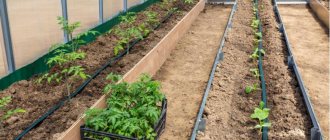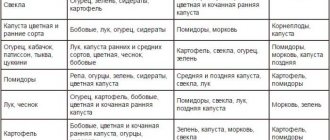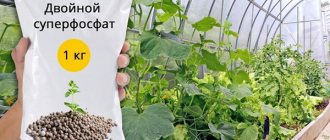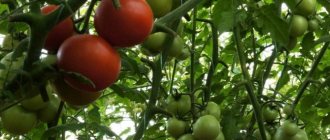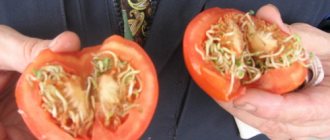Why do I plant tomatoes with two roots in one hole? How does this affect the harvest?
Caring for tomatoes takes me about 2-3 hours a week. I grow tomatoes in 2 trunks, in addition, I also plant them in twos. That is, 20 holes, but 40 roots.
Of course, it is more difficult to care for such plantings, but not twice as difficult. My greenhouses are 3x4m, so it’s cramped, but no offense.
Like all crops, I mulch tomatoes with a thick layer of grass (15-20 cm). Tomatoes really like this, because if you lift the mulch, you can see how the roots of the tomatoes spread under the mulch, and literally penetrate the mulch itself.
I view mulch not so much as protection from weeds and reducing water evaporation, but as a fertilizer that comes slowly and surely all season long. This grass must be eaten by one of the soil inhabitants, and something that can be easily absorbed by the plants will end up in the soil. Large, and especially dry grass is eaten slowly, which is why I always pay attention to what kind of grass I lay out. Not hay, not grass from under the trimmer, not dried grass, but fresh small grass. Electric lawn mower with grass catcher! I lay it out immediately, without drying it. I always water over the grass.
Microorganisms and worms eat organic matter near the roots. Plus, the tomato trunk is buried 20-25 cm into the ground and it is overgrown with roots. The tomatoes have enough nutrition; I no longer use any fertilizers.
I add herbs 3-4 times over the summer. Each time 15-20 cm.
The most labor-intensive process is tying. I tie each trunk to the ceiling. If one trunk interferes greatly with the other, then I use a garter to change the direction of growth of the trunk.
Description of the technology, its pros and cons
The planting method is quite simple: planting holes are dug, 2 tomatoes are planted in each hole. This technology has a number of advantages:
higher yield per unit area;- larger fruits;
- tomatoes ripen faster;
- saving space, garter material;
- this method is good for southern latitudes (thickened planting covers the roots).
There are also certain disadvantages:
- more planting material is required;
- compact planting requires constant attention from the gardener;
- excessively dense planting can lead to real “thickets”, which will complicate the process of care and rooting.
What tomatoes can be planted with several roots?
Two plants per hole can be planted with both determinate and indeterminate varieties of tomatoes. But for beginning gardeners or those who do not systematically garden (for example, they come to the dacha on weekends), it is better to plant only determinate varieties in this compacted way, since they do not grow too quickly and do not need pinching.
Another condition is that tomatoes of the same variety should be planted in one planting place! Each type of tomato has its own requirements for watering, fertilizing, and care, so even minor discrepancies can lead to the destruction of the crop.
Reference! Determinate tomatoes are plants that do not require pinching or staking.
Indeterminate tomatoes have unlimited growth of the main stem and require the formation of a bush.
How to plant tomatoes. Advantages of paired planting of tomatoes
- This method of planting tomatoes is advantageous in that it saves usable space on the site. Especially if it is not large in size. So, from one square meter you will be able to collect more fruits. In addition, if you plant tomato varieties with different periods of fruit ripeness in pairs, you can enjoy the harvest for a longer period.
- For those regions where there is predominantly hot weather without precipitation, this method of planting tomatoes in two roots not only saves square meters on the site for planting other crops, but also the plants shade each other, saving them from open sunlight.
- Especially if you plant the bushes diagonally, the moving sun will not be able to burn both plants at once. Since they will shade each other from different sides. In the south, gardeners plant tomatoes in trenches to further protect the seedlings from fading in the sun.
- There are gardening partnerships and human settlements in which neighboring plots are located very close to each other. Therefore, an emerging pest or an attacking disease can very quickly spread from a neighboring area to your plants.
- If you used paired planting of crops, then there is hope that at least one bush will survive. This is, of course, provided that the gardener notices signs of plant disease in time and begins an active fight against the pest or disease.
- In addition, this method of planting tomatoes is used so that at least one bush survives after transplanting the seedlings into the ground. Some tomato bushes are difficult to tolerate replanting and may even die. Then you will have enough healthy bushes and, accordingly, a good harvest.
Preparatory stage
The soil
- For planting tomatoes, choose a sunny place without drafts.
- The place should not be damp with close groundwater.
- The site for planting tomatoes is selected taking into account the correct crop rotation: it is impossible to plant tomatoes in the same place twice in a row; it is better if the predecessors of tomatoes are onions, garlic, carrots, cucumbers, cabbage, zucchini, beets, and pumpkin.
- Seedlings should not be allowed to be planted in place of other nightshades, as all diseases will be inherited.
- In autumn and spring, the soil must be carefully dug up in order to saturate it with oxygen and remove the roots of weeds.
- Before digging, you can scatter fertilizers over the soil to enrich it with nutrients (50 g of superphosphate per 1 sq.m. or 5 kg of manure per 1 sq.m.).
- 5–6 days before planting, the area should be spilled with a solution of copper sulfate (1 tablespoon per 10 liters of water): 1–1.5 liters of liquid per 1 sq.m.
Plants
Before planting, it is recommended to treat the seedlings with a weak and warm solution of potassium permanganate to prevent fungal diseases, to which young plants that are still fragile are very susceptible. Since 2 tomatoes will be planted in one hole, it is necessary to prepare a sufficient amount of planting material in advance.
How to determine whether seedlings are ready for planting in open ground? In this matter, indicators such as plant height, stem thickness and number of leaves will help determine:
- For early varieties of tomatoes:
- the optimal height of seedlings should be 20 – 25 cm;
- stem thickness – 5 – 7 mm;
- There should be 7 - 9 leaves on the plant.
- For late varieties:
- height – 20 – 25 cm;
- stem thickness – 5 -6 mm;
- number of leaves – 6 – 8.
What fertilizers to put in the hole before planting seedlings
If tomato seedlings were grown in peat cups, you don’t need to add anything to the hole before planting. In this case, the fertilizers that were applied when preparing the soil and the nutrients included in the cups themselves will be sufficient. The seedlings are not taken out of them, but planted in the ground just like that. In the ground, peat begins to decompose and releases nutrients to the roots.
Note! Applying fertilizer directly into the hole is a cost-effective way to feed your plants. In this case, fertilizers are not applied to the ground, which has no roots, but go directly to the root system of the tomatoes, which makes it possible to reduce their consumption overall
Each experienced summer resident has his own recipes for such feeding. Many of the fertilizers are universal and combine well with each other. Here's what experts recommend to put in the hole when planting tomatoes:
- Wood ash is a fertilizer containing important minerals such as potassium, magnesium, calcium, and sodium. Some minerals are responsible for the growth of green mass, others promote fruiting. It is enough to add a handful of ash into the hole under each plant.
- Superphosphate. The substance contains a significant amount of phosphorus in a form that is easily digestible for plants. You need to throw it in the amount of 50 g per hole.
- Complex fertilizer Universal. Made on the basis of humic substances, which are a growth stimulator, relieve stress after transplantation, and increase plant immunity. It is enough to add 1 tbsp to the hole. l. fertilizers
- Magnesium sulfate. It contains a lot of magnesium and sulfur. Positively affects the taste of fruits. Magnesium sulfate is especially useful as an additive to acidic soil.
- Vermicompost. This is a biologically active natural fertilizer, which is a product of processing Californian worms. Often recommended for use by agricultural specialists. Apply in quantities of 100 g.
- Giant is another humic complex fertilizer. It has a long-term effect and is available in granules. It should be poured at the rate of 1 tbsp. l. per plant.
- Kemira Universal. It is a complex of essential minerals. Usage rate: 1 tbsp. l. to the hole.
The recommended dose of fertilizers should not be exceeded. Their excess is no less harmful than their deficiency. This is especially true for industrial chemical fertilizers.
Instructions
Planting holes are dug to a depth of 20–25 cm, the distance between them is 40–50 cm, the distance between rows is 50–60 cm.
- Prepare holes for planting.
- The holes should be well watered and wait until it is absorbed into the ground (the hole is completely filled with water).
- In the planting hole, depressions are made into which the tomatoes will be placed.
- A pair of tomatoes is buried in the ground at an angle of 45 degrees.
- From above, the roots of the plants are covered with soil (can be dry), which is lightly pressed at the base of the stems for better fixation.
- Each hole needs to be watered with another 1 liter of water.
Calculation example
Let's say you have at your disposal a greenhouse 3 by 4 m, divided by a central path 60 cm wide into 2 equal parts. On the left and right we have rectangles of land 1.2 m wide and 4.8 m2 in area.
On one side, we plant 12 indeterminate bushes ((1.2×4)x2.5) in 2 rows, each 60 cm wide, with a step of 67 cm in a row, and on the other side, 24 determinate plants in 2 rows according to a 60× pattern 33 cm. That is, a total of 36 bushes will be planted in this case.
If you plant only indets on both the left and the right, then only 24 bushes will fit freely, and if only children, then 48 bushes.
Growing and care
Watering
There is no need to water for 7–8 days, until the seedlings take root. For young plants, the amount of moisture they receive during planting will be sufficient.
The best time for watering is the second half of the day, towards evening. It is advisable that the tomatoes no longer be exposed to direct sunlight. Tomatoes do not like moisture getting on their leaves - this can cause them to develop fungal diseases.
Watering is done only at the root, it is better if it is drip. From the moment the seedlings are planted until the first ovary, the soil is only moistened, preventing it from drying out. When the tomatoes begin to bear fruit, they should be watered systematically and abundantly, since the root system needs to intensively nourish the plant, especially if there are two plants in the hole.
Top dressing
Two tomatoes in one hole need “enhanced nutrition.” Preferred fertilizers:
- superphosphate;
- humus;
- ash.
You can use chicken manure (1:15, 1 bucket for 10 - 15 bushes).
Loosening and hilling
Each time after watering, the soil should be loosened, and 15–18 days after planting, many vegetable growers recommend hilling young plants to a height of 12 cm.
Mulching
In order for the soil to retain moisture longer and the roots to be shaded, many gardeners mulch the beds and cover the soil surface:
- mown grass;
- straw;
- peat;
- sawdust;
- husk of sunflower seeds, etc.
In addition, mulching will prevent the growth of various weeds.
Bush formation
In order to increase productivity, improve the quality of fruits, and speed up the process of their ripening, tomato bushes are formed in a special way. Experienced vegetable growers form each of the double tomatoes into 2 stems. Thus, in one hole a bush of 4 stems is formed, but 2 roots feed them, which, undoubtedly, only has a positive effect on the yield.
Reference! To form a bush with 2 stems, all shoots are removed from the main stem, except those growing under the first flower cluster. On the main shoot, leave 4 flower clusters and pinch the top, and on the side shoot, leave 3 fruit clusters and also pinch them.
Leaf trimming
It is imperative to get rid of the lower leaves for better ventilation of the plant.
Common mistakes and their prevention
- Excessively thick mass of tomatoes. The main reason is that the moment of timely stepsoning was missed. This is especially true for indeterminate varieties. The consequence is a lack of harvest. Plants should be constantly monitored, bush formation and pinching (breaking off side shoots 3–4 cm long) should be carried out in time.
- The seedlings “interfere” with each other. The reason is too small a distance between plants. The distance between shoots of determinate varieties should be 15-20 cm, between indeterminate varieties - up to 30 cm.
- The planted tomatoes do not grow and stand in one place. One of the main reasons for this phenomenon is the lack of nutrition for plants. When planting in a hole, you can add a variety of organic fertilizers (manure, humus, onion peels, eggshells, banana peels, etc.), mineral fertilizers (superphosphate, ammonium nitrate), and complex fertilizers are also suitable.
Every gardener is free to decide for himself how to grow plants. But you can always experiment, otherwise you will never be able to choose the optimal method of growing tomatoes that is directly suitable for a given area and given weather conditions.



